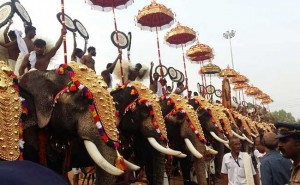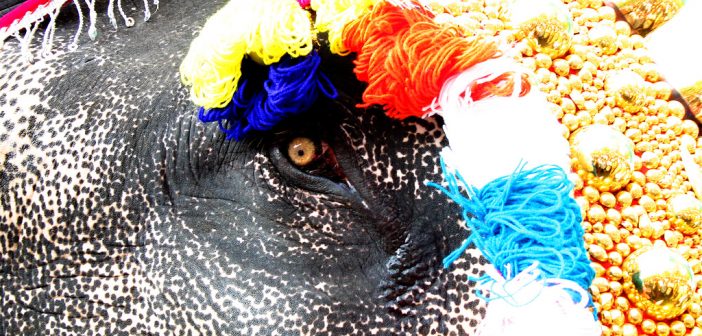(Featured image credit Salvatore Barbera, used under CC BY-SA 2.0)
It came as an embarrassment to festival lovers when Hollywood actress and long-time animal rights activist Pamela Anderson offered 30 faux elephants to replace live elephants used in the Thrissur Pooram festival in Kerala. This South India temple festival is the pride of every festival lover, so much so that it has over time become a global tourist attraction. The main attraction of this festival is the mass elephant parade, which has drawn criticism from animal rights activists and organizations alleging cruelty towards elephants. Recently, the apex court intervened in the issue, triggering dialogue between organizers, worshipers and animal rights activists.
Why Elephant Parades?

Elephants during Pooram. Photo: i.ndtvimg.com
Traditional temple festivals in South India use elephants, cows and bulls as part of their rituals. Annual temple festivals in Kerala use elephants for various rituals and parades. Pooram is an Indian term for temple festivals; it is a cultural celebration bringing elephants together with artists and fireworks in a single venue. Thrissur, the cultural capital of Kerala hosts the biggest Pooram in the world with 60 plus elephants in a row and many other cultural attractions. This 218 year old festival was designed by the ruler of the time to make a grand spectacle, and his arrangements are still followed throughout the ritual.
During the festival, the best elephants are paraded in the premises of the temple and are made to carry idols of the deity in long processions. Not all elephants are allowed to parade in a Pooram; only male elephants with certain required qualities are considered for parades. The elephants should be tall and have broad ears, long tusks and earth touching trunks. In some temples, elephant races are conducted to select the right elephants to carry the deity. The elephants are ranked and given positions according to their features and character, which in turn provides benefits to the owner of each elephant for the festival season. Major festivals showcase at least half a dozen elephants, and most of the temples in South India participate as well, though in smaller numbers.
What Does the Law Say, and What Really Happens?
Understanding the necessity of protecting these giant animals, the government of India introduced Project Elephant in 1992. The Ministry of Environment and Forests provides financial and technical support for the conservation of Asian elephants. Welfare of captive elephants is also under the jurisdiction of the Project. The Asian Elephant Conservation Act of 1997 also funds the conservation of elephants internationally. Animal Welfare Board of India (AWBI) is the government body concerning the rules and regulations of animal welfare. The Kerala Prevention of Cruelty to Animals Act (1960) and Captive Elephants (Management and Maintenance) Rules (2003) are two important laws regarding captive animals. Their rules and regulations put forward clear guidelines regarding the parading of captive elephants. Section 23 of the Kerala Captive Elephants Rules (2003) makes it mandatory to use only registered elephants for exhibition or performance; the owners have to get prior permission for this. The owners are also responsible for registering the elephants with the Animal Welfare Board. The Prevention of Cruelty to Animals Act (1960) and Wildlife Protection Act (1972) prohibit forcing elephants to stand in proximity to high decibel sound. The rules also demand that the animal be medically fit, and require timely medically inspection by a veterinary doctor before parades.

Wounds covered with paint
No one would demand stopping such grand cultural events abruptly. But after understanding the situation of animals and the problems they face during these festivals, one may ask for better treatment of animals. There are various reasons for rethinking the issues of animal welfare and human security raised during such events. Temple festivals vary from place to place; they may last from a few hours to a few weeks. In between the colorful festival scenes, the human visitors are provided with retirement facilities. Yet for elephants, the festival is a laborious ordeal beginning with transportation to the site, being either moved in trucks or forced to walk kilometers without rest. During the festival procession, elephants are forced to walk for hours, and cannot move during rituals. Their legs are bound with huge iron chains for safety so that they cannot run or move freely. They are forced to walk under the scorching sun accompanying the loud sound of instruments. They are decorated with metal armor and made to carry up to four people with fans and parasols on their backs.
Most festivals do not follow the regulations according to AWBI and use aged and ill elephants for parades. During this year’s Thrissur Pooram, more than 60 elephants were paraded, of which 30 were found unfit according to AWBI officials. They found that elephants with wounds, impaired vision, and cracked nails were used in the parade. The report published by AWBI notes that black paint was used to cover wounds on the animals’ bodies. They also found mahouts using banned sticks to control the animals by imparting pain. Animals were forced to stand in small spaces near fireworks and heavy instruments, which is squarely in violation of WPA and Sound Pollution Regulation rules. These violations can be seen in most of the festivals, as organizers and owners do not follow the guidelines under Performing Animals (Registration) Rules.
Other Concerns
The tourism lobby’s intervention is evident in advertisements of the cultural festival as ‘India’s greatest elephant festival’. Thus festival lovers demand to retain elephant parades in the festival. The elephant owners also push for the continued use of elephants so they can make a profit from their business. Since old elephants cannot be used in the wood industry, the only profit they can bring their owners comes from performance. Festival organizers argue for the use of elephants in the rituals based on tradition, and are backed by worshipers and religious spokespersons. For these people, Pamela Anderson’s idea of using faux elephants made of bamboo and papier-mâché overlooks the cultural context and history of the festivals. Yet for the animal rights activist, such a solution would be a practical way to stop the cruelty against elephants. There should be dialogues on this issue until measures to stop the abuse of animals during festivals are achieved.
__
Further Reading:
Report on Inspection of Captive Elephants used in Thrissur Pooram 2016, Animal Welfare Board of India Ministry of Environment, Forests and Climate Change





